Do IT Tickets Give the Full Picture of Issues in the Digital Workplace?
As businesses now rely on technology to carry out most, if not all their operations, the volume of IT issues that arise on a daily basis has grown significantly. From large corporations to small startups, operations are primarily run via a digital workplace that encompasses a huge variety of technology, such as Microsoft Office, Zoom, Google Meet, MS Teams, Salesforce, and many more.
It falls upon the IT team of a company to ensure that end users can efficiently carry out their business tasks with enterprise applications, free from any digital hindrances. Most organizations manage these technical issues with an IT ticketing system.
The service desk uses IT tickets to track issues and measure vital SLAs like mean time to resolution (mttr). Do IT tickets give the full picture of issues in the digital workplace, or do these tickets only represent a tiny portion of a much larger stack of workplace issues?
Finding The Answer: Do IT Tickets Give an Accurate Picture of Digital Workplace Issues?
From Nexthink’s experience and insights: the answer is a resounding NO! The full picture of problems in the digital workplace doesn’t begin or end with the number of IT tickets logged by the helpdesk. The full picture must encompass even potential issues that lie hidden in the depths of a company’s IT infrastructure.
Think of this scenario like you would an iceberg: the tip of the iceberg is all we can see clearly. Only 5% of all issues are reported in the form of IT tickets. The remaining 95% of all problems are often an enigma to companies that rely solely on IT tickets to troubleshoot IT issues.
The Iceberg Model
This is how Nexthink visualizes and diagnoses the IT infrastructure of any company:
User-initiated-tickets logged at the service desk only comprise 5% of all actual IT issues. These are the issues flagged by users, visible to the ITSM of an organization.
45% of all actual issues on the CTI remain unreported by users, and stay beneath the surface of what looks like a relatively problem-free digital landscape This could be due to several factors – the user could be unaware of the issue, they could be managing without bothering to get it fixed, or attempting to troubleshoot the problem on their own.
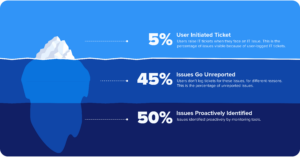
The remaining 50% of issues are holistic issues that Nexthink’s digital employee experience monitoring works to proactively identify and mitigate. These issues may not cause any immediate emergencies but have the potential to disrupt and hinder the employee experience when using an application.
As they say, a small spark could light up an entire forest, so staying proactive and identifying these sparks before they blow up is the best bet for any forward-thinking organization.
Let us explore this with a real-life IT Use Case.
IT Ticket Use Cases
An Enterprise with MS Teams Application Issues without Nexthink
Scenario A: Users are aware of the app issue and log incidents
MS Teams is causing issues for users. A number of users have reached out to the Service Desk for assistance, and their requests have been logged as tickets in ITSM under the Collaboration – Office – Teams CTI.
These tickets have been classified under 6 to 7 categories: Teams connectivity issues, hardware issues, crashes/hangs, wrong configurations, and OKTA team access issues. In total, 369 tickets have been flagged. But is this the full extent of Teams issues across the organization?
Let’s measure this situation using a calls-per-asset ratio. Assuming that the organization has 1000 assets (users or devices), the calls per asset ratio of Teams issues, as per ITSM, is 369/1000 = 0.37.
Scenario B: Users are unaware of the issue and/or neglect to log incidents
We already know that only a fraction of all IT problems are logged by users in the system as IT tickets.
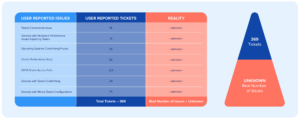
The set of remaining users can take one of the following approaches when faced with an IT issue:
- They may not be aware of the problem.
- They may recognize the issue but not attempt to fix it.
- They may try to solve the problem on their own.
- They may not believe the service desk can help them.
- They may seek support from alternative sources.
- They may encounter compliance, policy, or security-related issues.
Yet even with this knowledge, it can be challenging, and nearly impossible, for IT teams to determine the precise number of incidents where a legitimate issue has occurred with MS Teams but has not been reported back to the service desk.
So while this organization may log 369 tickets per 1000 devices, that barely scratches the surface of the full scale of issues that MS Teams users are experiencing.
An Enterprise with MS Teams Application Issues with Nexthink
The Nexthink Platform has the capability to identify all possible MS Teams issues related to the 6 to 7 categories mentioned in the ITSM. These issues are evidently prevalent among the users but have not been recorded as issue tickets in the ITSM pipeline. You could view this as a good thing – fewer tickets means less work for the IT team! But is that really the best attitude?
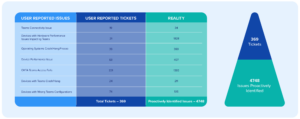
But a prescient business will see these unreported incidents for what they are: a ticking time bomb. The unaddressed issues could escalate at any moment, causing a considerable negative impact on both the IT infrastructure and business function.
When these issues inevitably reach a critical level, they may become too difficult to handle due to their volume and speed of impact.
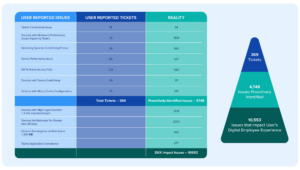
In this use case, the Nexthink Platform has identified 4748 issues that are not logged as tickets but belong to the categories mentioned in the ITSM. The calls per asset ratio of these non-ticketed issues is 4748/1000 = 4.79.
The Nexthink Difference
The pivotal difference that Nexthink brings to this scenario is proactive problem solving. The Nexthink Digital Experience Platform identifies all the possible experience issues the user may face with the specific application, not just the ticketed ones.
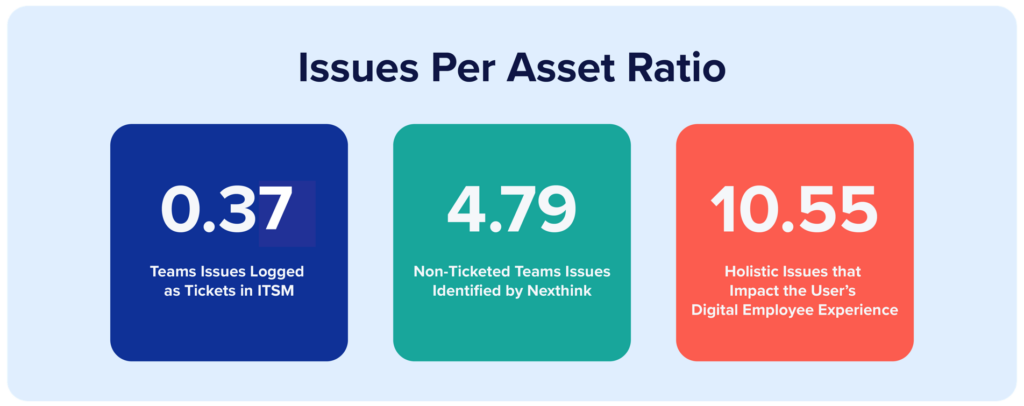
The Nexthink platform goes beyond surface-level analysis to delve deeper into all potential issues that could impact a user’s digital experience with MS Teams. These issues may not be directly related to Teams, but they have the potential to hamper the users’ experience.
This proactive identification results in calls per asset ratio of 10553/1000 = 10.55, indicating a significant number of potential problems that could affect MS Teams users.
The Answer?
This brings us back to the question: Do IT tickets accurately capture the full range of issues in the digital workplace?
Here are the official calls per asset ratios for each of these situations:
- Teams issues logged as tickets in ITSM – 0.37
- Non-ticketed Teams issues identified by Nexthink – 4.79
- Holistic issues with the experience identified by Nexthink – 10.55
Evidently, the Nexthink Digital Experience Platform’s capabilities exceed those of a regular IT help desk. With monitoring and proactive problem-solving, the company can easily identify and resolve a far larger number of issues. While IT tickets are useful alerts for IT teams, they fall short when one needs an idea of the full scope of issues in the digital workplace.
Ready to learn how Nexthink could help your team find and fix issues faster? Request a demo today.
Related posts:
- The Ultimate Guide to Digital Workplace Observability
- The Ultimate List of Digital Employee Experience Job Titles
- 5 Ways Nexthink Amplify Strengthens Your Service Desk
- How Nexthink Provides Complete Visibility into Your Digital Workplace